Sony Bravia X90J Review
Does the mid-ranger that's replacing last year's well-received XH90 tick all the right boxes?
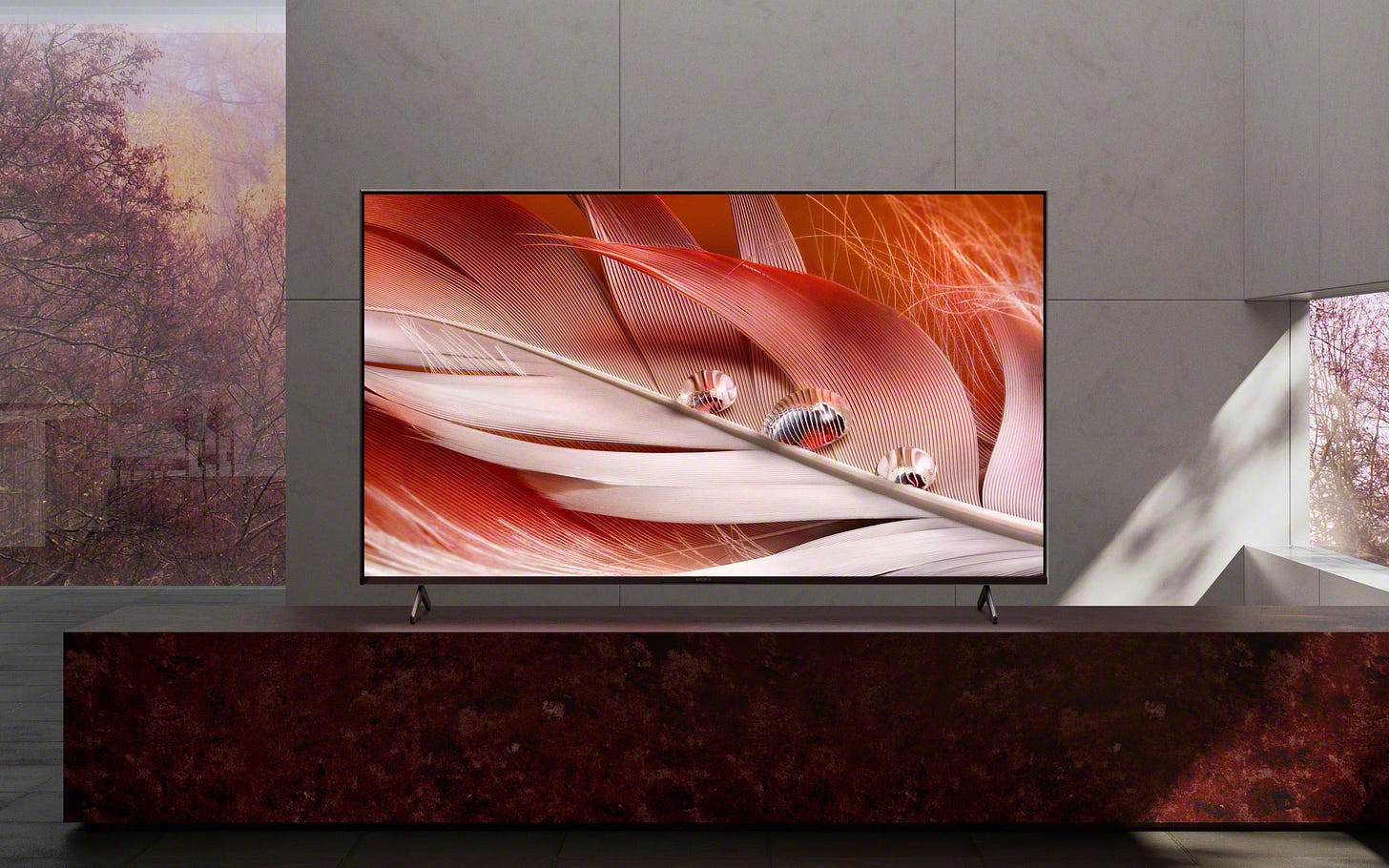
With 8K still not quite ready for mainstream adoption yet and out of reach for many consumers, Sony keeps its focus on 4K mid-range and hi-end models - rightly so, in fact, as it seems that there's still room for improvement over what's offered by the Japanese company and others up until now. What's more, in the LED/LCD category Sony chose not to try its hand at MiniLED this year, relying on tried and true local dimming or traditional backlighting tech for all of the new non-OLED Bravias instead. The Japanese do have an ace up their sleeves in 2021, though: the new Cognitive Processor XR, which promises to deliver even better results than the already industry-leading ones offered by Sony in the field of picture processing.
What most consumers would like to know, though, is this: can the new processor make a difference when used on a mid-range TV model? That model is none other than the Bravia X90J, the successor of the highly successful (and somewhat controversial) Bravia XH90, a fact which naturally leads to another question: is the new model better than the one it replaces? Last but not least: can the Bravia X90J justify the price premium it commands over almost all other mid-range LED/LCD TVs in the market right now?
I spent 2 weeks with the 50-inch model to get some answers. Here they are.
Nice design, solid built, adequate sound
It's a given that mid-range TVs simply cannot look as impressive as premium, much more expensive ones, but they can still be nicely designed and the X90J is a good example of that: its looks are understated - there’s not a single element that immediately stands out - but its overall style is pleasant in a minimalistic way. People who are looking for a striking TV set might not be too impressed by it, but after a few days it becomes apparent that this is a conscious choice on Sony’s part: the TV frame draws zero attention to itself, never distracting the viewer’s attention from the screen. The bezels around it are not the thinnest around by any means, but they are thin enough so as not to be off-putting. All in all a modern, maybe unremarkable, but likable and effective design.

The Bravia X90J is meant to be an affordable model by Sony’s standards, so one might not expect it to be as well-built as other more expensive sets the company offers. This is true to some extend, evident by the plastic frame and back of the TV, but it actually proves to be a solid, carefully constructed device with admirable attention to detail. It can be wall-mounted of course (its ports being all on the left-hand side help with this), but people who plan to put it on furniture will appreciate the way its metal feet work (in all models of the X90J but the 50-inch one): these can be put either in the middle or at the edges of the TV frame, not only making the placement of the X90J on furniture not as wide as the TV itself possible but also allowing for a soundbar to be put underneath it if it is.
Speaking of soundbars, people considering the X90J will probably need one at some point. This Bravia’s sound is not bad per se - meaning that it’s no worse than that of other TVs in this price range - but it's not exceptional either: it offers better bass than last year's XH90, but the lack of detail across all frequencies is evident as the built-in stereo speakers are not powerful enough (turning the volume up is practically necessary although distortion is not a big issue). Sony has even attempted to simulate positional sound but there's only so much one can expect from admittedly rather weak speakers. Typical over-the-air TV content and sports sound OK, but movies or shows may sound "flat" and uninspiring as a result (dialogue remains thankfully clear). The X90J fully supports eARC, so top-quality sound (such as Dolby Atmos and DTS:X) can be redirected to an external speaker system that will actually do modern films and TV shows justice.
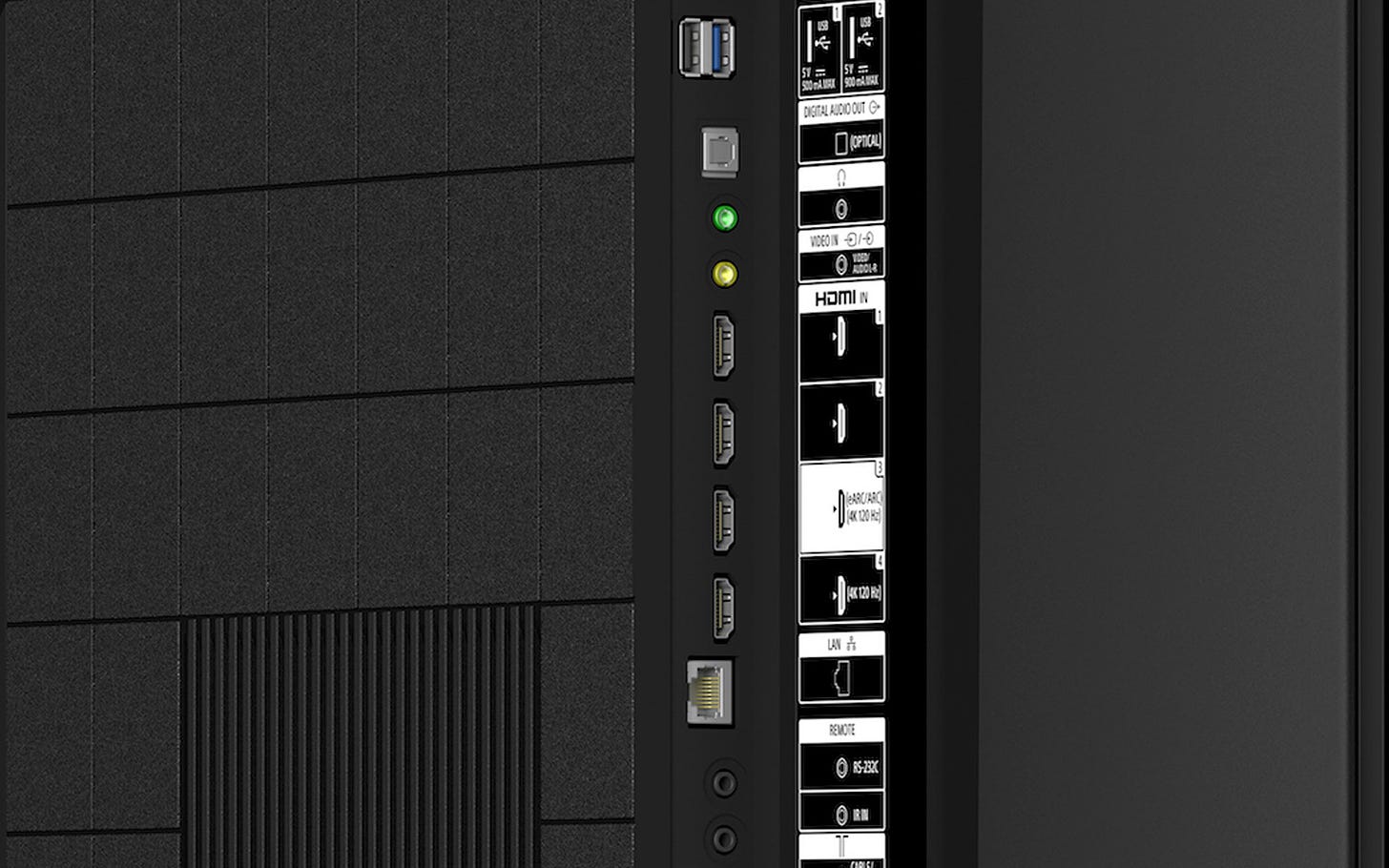
It’s a shame that, yet again this year, the HDMI port that supports eARC happens to be one of the two of major interest to gamers: the full-bandwidth (48 Gbps) HDMI 2.1 ports where a PlayStation5, an Xbox Series S|X or a hi-end PC can be connected in order to make use of functions such as VRR, ALLM and others. These functions Sony has promised to activate through a firmware update at some point in the future. Just two HDMI 2.1 ports, though, means that in practice consumers won't be able to use a soundbar and two gaming consoles - unless the soundbar itself offers HDMI 2.1 ports - so they will have to make a choice down the road. An HDMI 2.1-equipped receiver seems to be the safest way out of this for the time being. The other two HDMI ports are of the 2.0 variety, perfectly adequate for everything else from disc players to media players to older consoles/PCs.
The rest of the ports one expects of a good modern Smart TV are all there: an Ethernet port for wired connectivity (sadly it’s of the Fast Ethernet variety), a couple of USB ports (for multimedia file playback from external storage devices) plus some legacy ports (such as composite video in or optical audio out). The XH90 offers faster wireless connectivity than wired (Wi-Fi AC) plus Bluetooth 4.2 for a variety of uses. Chromecast functions come as standard and Apple device owners will be pleased to know that AirPlay2 and HomeKit work as intended. Amazon Alexa is also supported by the X90J for consumers who prefer it to Google Assistant.
Picture quality: you win some, you lose some
All of the top five Sony Bravia TV series for 2021 use the company's new image processor, the Cognitive Processor XR, but the X90J is the model with the least capable backlighting tech - a necessary choice the Japanese made in order for it to be affordable to mainstream consumers. Did Sony manage to strike a balance between that necessity and the kind of picture quality that consumers expect of a Bravia TV, even a mid-ranger?
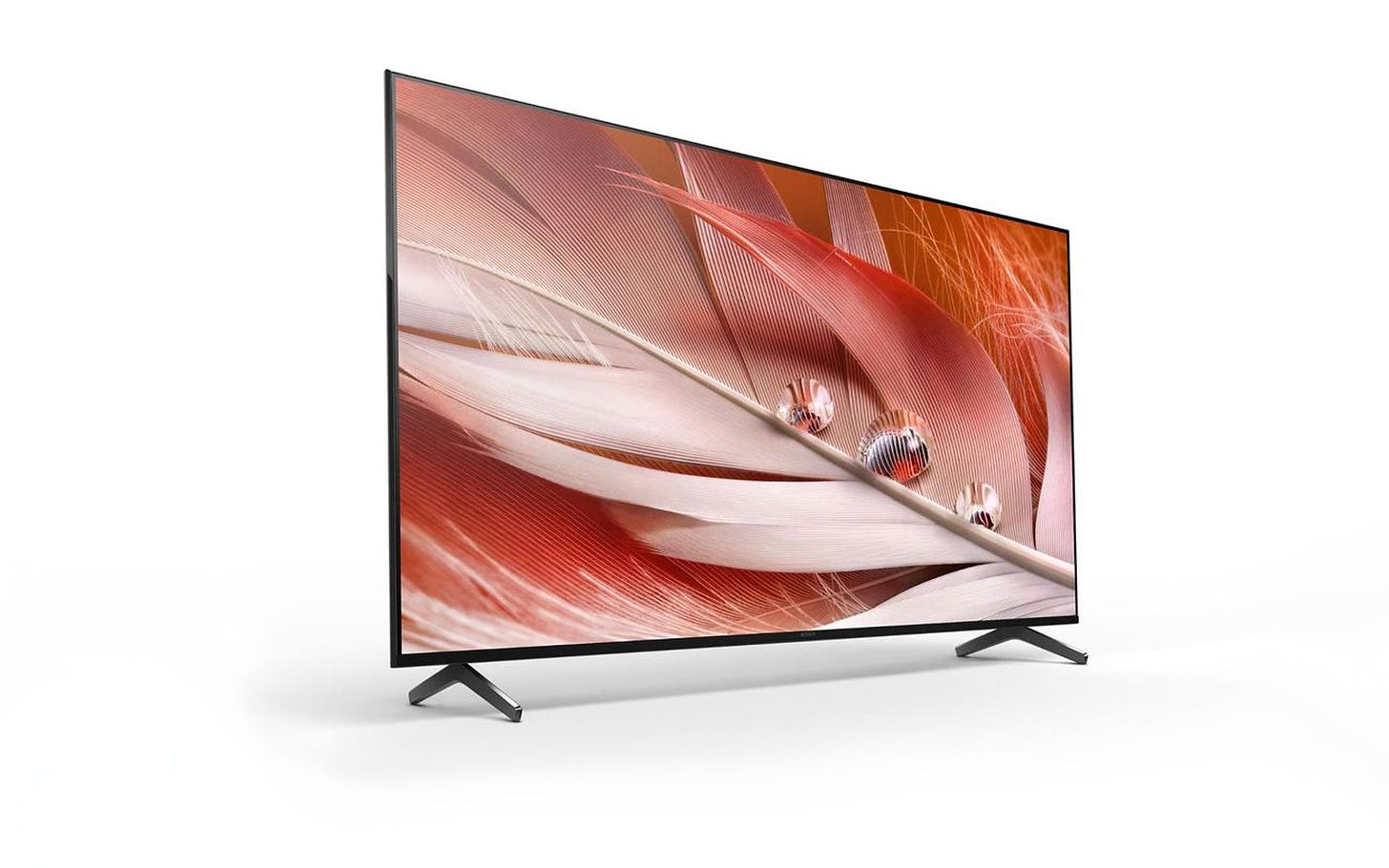
It all depends on the usage scenario, it seems. There's no getting around the fact, for instance, that the X90J features a small number of controllable "zones" for local dimming in its backlighting system: the 50- and 55-inch models offer just 24, while bigger ones offer 32 or 48, but they are all low numbers for their respective screen diagonals. In practice, this means that (a) there's bound to be some blooming (haze around bright objects on dark backgrounds) in modern HDR content with plenty of highlights and (b) that the TV, actively trying to mitigate that problem, will lower the overall brightness of the screen at times. The former is noticeable in many situations regardless of environmental lighting, the latter is not that noticeable in bright environments but often is in dark ones.
It's just asking too much of a mid-range TV to not have these issues, of course - even TV sets costing four or five times as much exhibit those, as the only way to not have any blooming at all in dark environments is going for an OLED model. It's just that, strangely, Sony's legendary zone-controlling local dimming algorithm seems to be not as effective this year as they were on last year's XH90 (which featured 32 zones). That algorithm still does an amazing job in typical real-world content, but the Japanese company has truly raised the bar during the last few years in the image processing and backlight control department, so expectations are understandably high too. It seems that, in 2021, this bar will probably only be met by Sony's higher (but much higher-costing) models.
The good news is that in most other situations - outside of demanding HDR content and torture tests, that is - the X90J does deliver the kind of quality picture one expects from a Sony Bravia. It is natural, balanced, never over-saturated. Depending on the picture mode selected the colors are either impressive but slightly inaccurate or somewhat muted but quite accurate: sports fans should go for the Standard mode for better motion and bright colors, while movie lovers should go for the Custom mode for "creator-intended" palettes and "cinematic" (soap opera effect-free) motion. As the X90J is based on a VA-type LCD panel, contrast and black levels are generally very good - even great on many occasions - but viewing angles are inevitably narrow. Reflection handling could also be better, but it's not a deal-breaker.
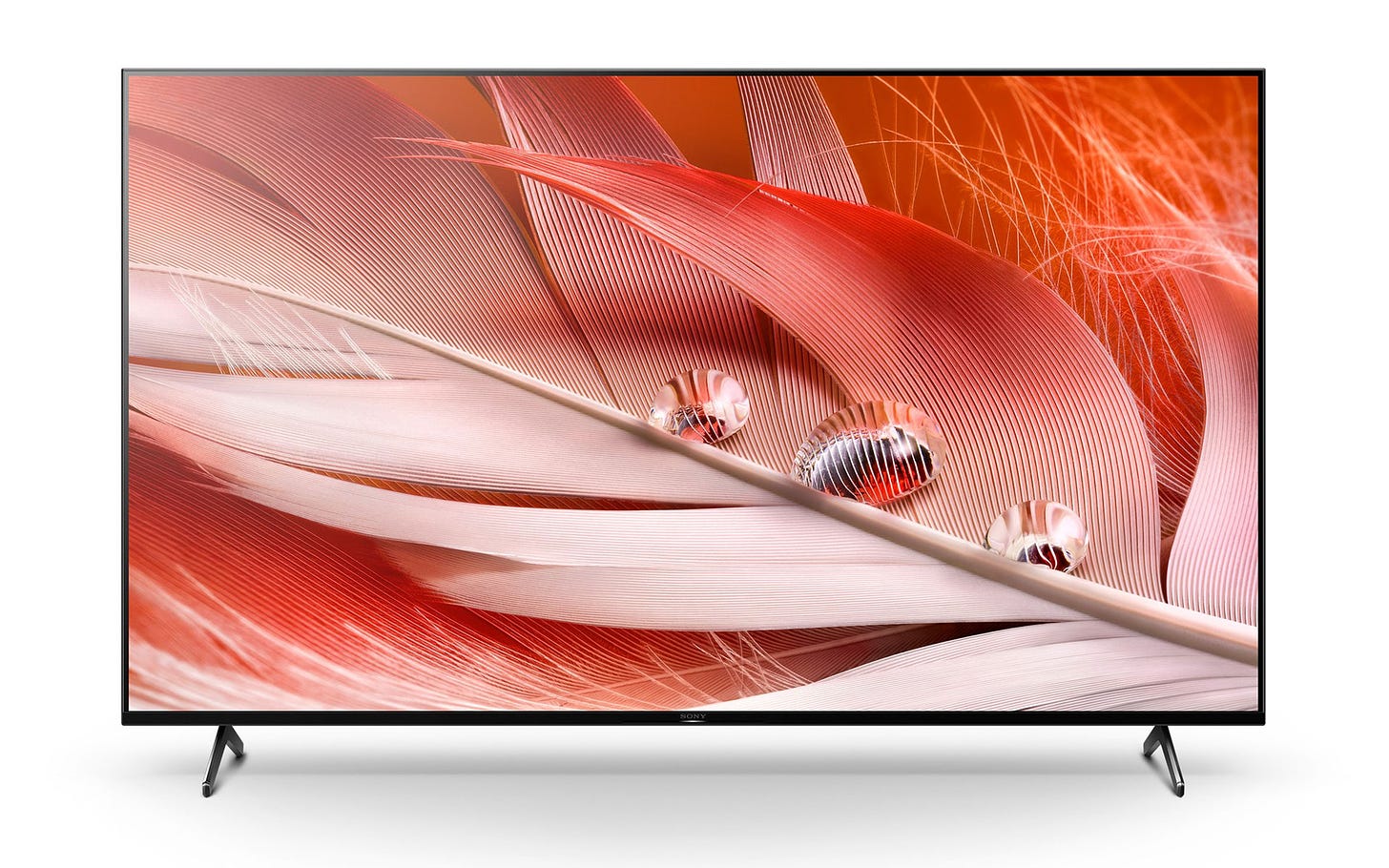
The interesting question is: given the low-numbered local dimming array of the X90J, can the new, powerful Cognitive Processor XR make a difference? Amazingly, it seems that it can. It's not a night-and-day difference by any means, of course, as Sony's picture processing already was the best in the business and room for improvement was not that big to begin with, but... yes: compared to the picture last year's XH90 is offering - with the exact same settings, on the same material - the X90J delivers a more punchy, pleasing picture that's still under perfect control. The Cognitive Processor XR "touches up" every frame just enough so as to give it a bit more depth and texture, never going overboard with object sharpening or suppressing detail. Colors are not improved by much (Sony generally dislikes messing with those for good reason) but, if one looks for them, some adjustments are there. Purists always believe that less is more when it comes to picture processing, especially in movies, but the Cognitive Processor XR seems to only have a positive effect on film material overall.
In all other aspects of image processing, one can expect the same great results Sony delivers for years now: the Cognitive Processor XR does not seem to offer much more as far as the "traditional" ways of picture handling are concerned. Upscaling from lower resolutions to 4K is as excellent as it always was (there seems to be some improvement in clarity when displaying overly-compressed material but that's just about it), motion handling is very good (one does need to be a bit careful with the settings offered though), de-interlacing and noise reduction from legacy sources are highly effective. Then again, almost all of the above applies to last year's Bravia XH90 as well... so in the case of the X90J they can only be described as "expected", not "noteworthy". It's the higher-quality material that the Cognitive Processor XR seems to be more willing to enhance and that's perfectly fine.
All in all, judging the overall picture quality offered by the X90J greatly depends on one's expectations and use cases. It is a mid-range class TV, so Sony simply had to make compromises in the backlighting system of this model: a much better local dimming array would have meant a much more expensive X90J, which would miss the point of it being affordable. Helped by the company's superior zone-controlling algorithm and the Cognitive Processor XR the X90J ultimately delivers the kind of picture that will satisfy most consumers in most situations, which is what mainstream TVs are meant to offer. People that demand much more in pure cinematic picture quality will be looking at more expensive TV models - and probably other display technologies - anyway.
Verdict time: a very good TV that can be made better
All of the above - plus Sony's 2021 TV lineup as a whole - leave the X90J in a somewhat strange position. On one hand, it's not the most "cinematic" television the Japanese offer this year: that honor rightly belongs to more capable (and much more costly) new Bravia models. It also can't be recommended as a "gaming TV" until Sony releases the firmware update that will enable the VRR/ALLM functions offered by its HDMI 2.1 ports.
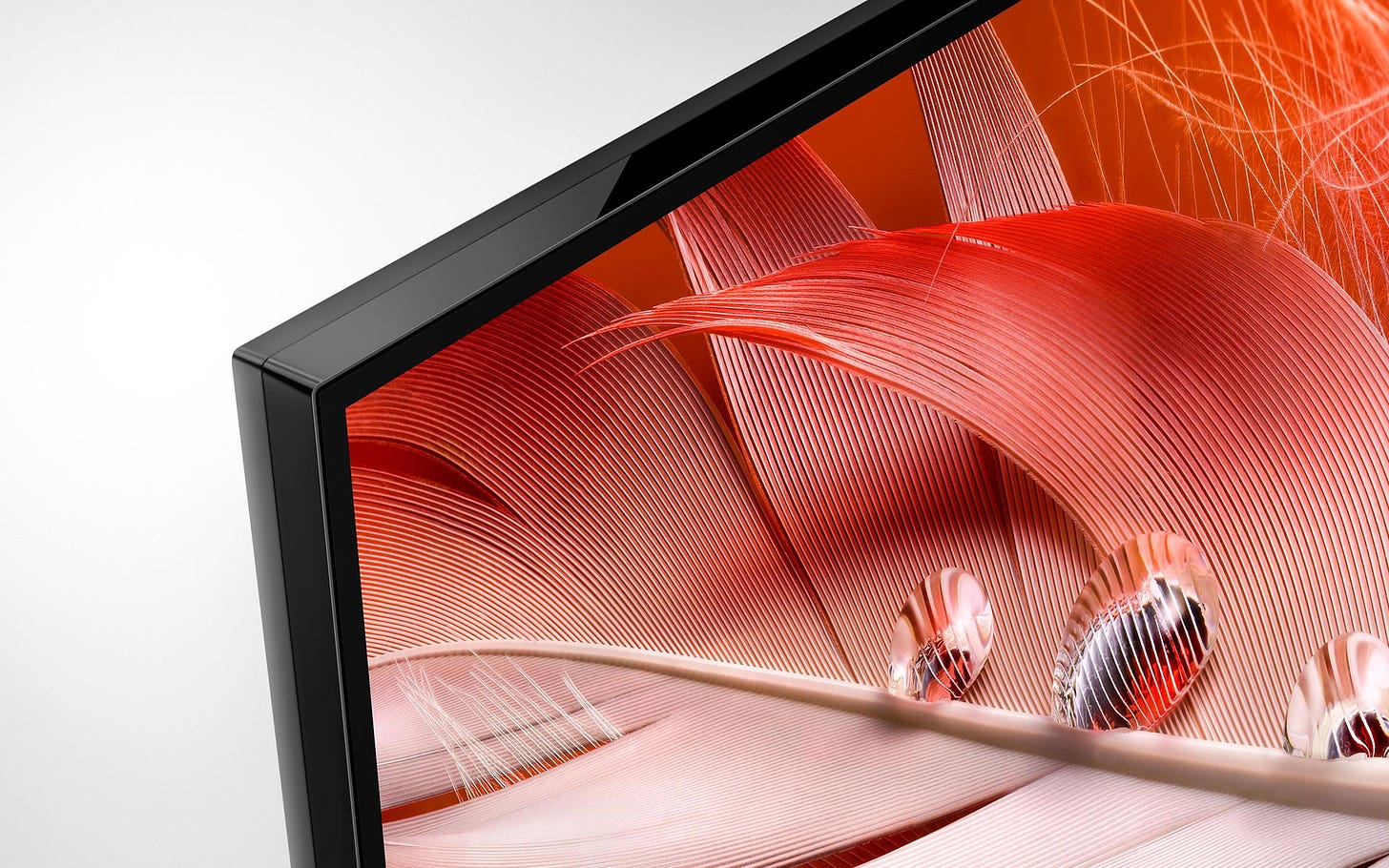
On the other hand, the X90J is clearly better than its predecessor, the successful XH90: it fixes some of that model's shortcomings, offers superior picture processing and takes advantage of the new Google TV operating system (which opens a path to future upgrades). It's also a very good "general purpose" TV, meaning that it may not excel in any specific use case but it usually offers the kind of picture quality most mainstream consumers will be perfectly happy with. In that sense, it is easy to recommend as a mass-market TV for 2021.
Whether the X90J is an option worth the premium it commands over competing LED/LCD TV models from other manufacturers is a different discussion. There are some notable models this year from the likes of TCL, Vizio and HiSense which can indeed give the X90J a run for its money as they offer a comparably good picture at a lower price. The X90J is still superior in the image processing department, though, while the Google TV operating system offers the widest selection of apps and services (let us not forget about that upgrade path too). Sony has also proved that it means to support its TVs for a long time while other manufacturers have a... shall we say chequered past in that regard. This remains important to some.
The X90J is, all in all, a good TV then. Great, even, by mid-range standards. It's just that Sony is the manufacturer that offered us the legendary Bravia X900E and X900F models, two of the best mid-rangers ever made. Is it too much to ask Sony for a model like those, one that strikes that perfect balance between performance and price, in 2022? Let us hope not!


